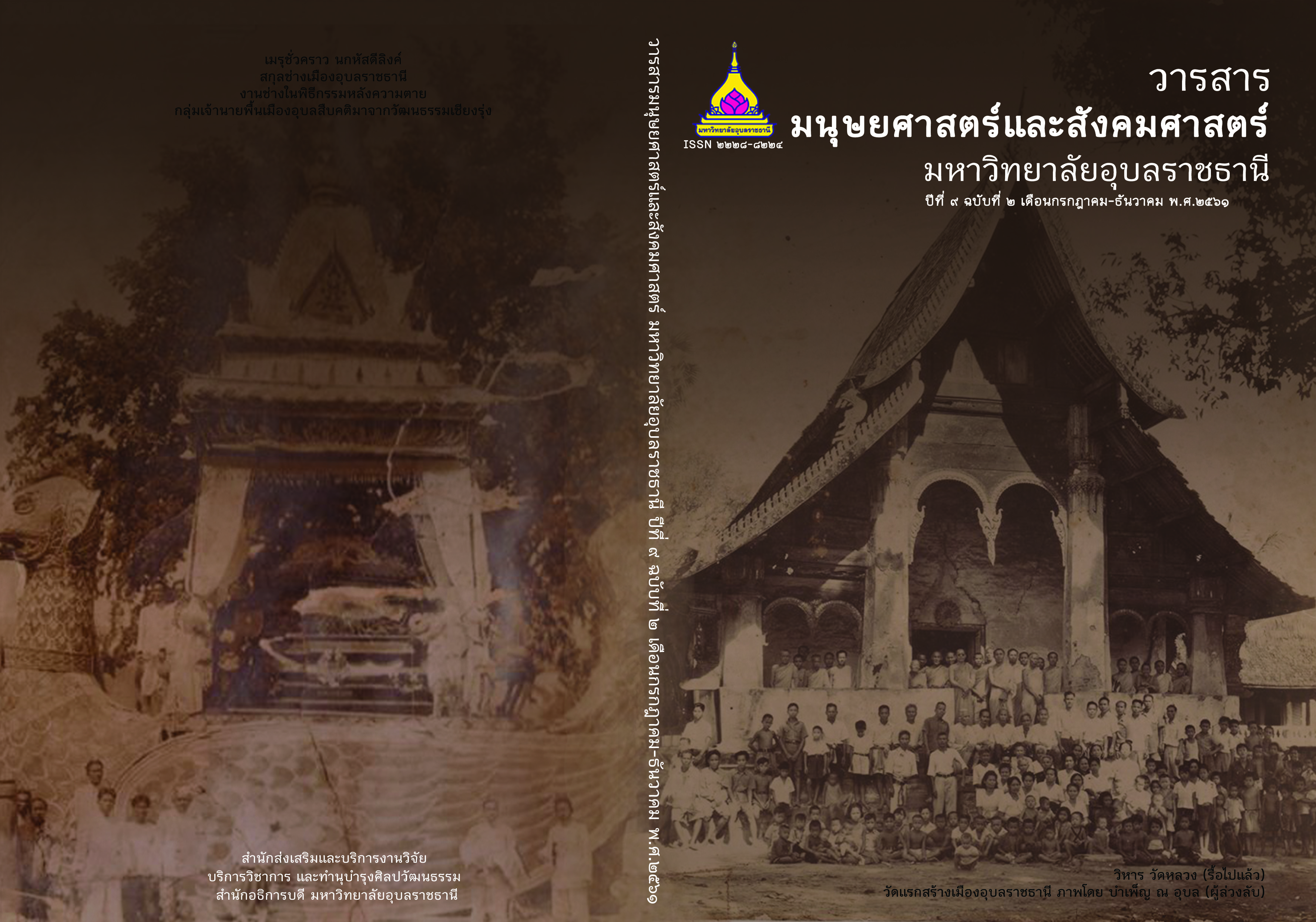ปัจจัยด้านพลวัตสภาพแวดล้อม ผู้นำ และความคิดสร้างสรรค์ ที่มีผลต่อการดำเนินงานของวิสาหกิจชุมชน จังหวัดลำพูน
Main Article Content
บทคัดย่อ
การวิจัยครั้งนี้มีวัตถุประสงค์เพื่อศึกษาระดับความคิดเห็นของสมาชิกวิสาหกิจชุมชนเกี่ยวกับปัจจัยด้านพลวัตสภาพแวดล้อม ผู้นำ และความคิดสร้างสรรค์ที่มีผลต่อการดำเนินงานของวิสาหกิจชุมชน จังหวัดลำพูน และศึกษาความสามารถของปัจจัยดังกล่าวในการอธิบายความผันแปรของผลการดำเนินงานของวิสาหกิจชุมชน กลุ่มตัวอย่าง คือ สมาชิกกลุ่มวิสาหกิจชุมชนของจังหวัดลำพูน จำนวน 278 ราย สุ่มตัวอย่างด้วยเทคนิควิธีการเลือกแบบมีโควต้า เครื่องมือที่ใช้เป็นแบบสอบถาม สถิติพรรณนาหาค่าร้อยละ ค่าเฉลี่ย ส่วนเบี่ยงเบนมาตรฐานและสถิติอนุมานวิเคราะห์ด้วยเทคนิคการถดถอยพหุคูณ
ผลการวิจัยพบว่า สมาชิกส่วนใหญ่เป็นเพศหญิง ประกอบวิสาหกิจชุมชนด้านแปรรูปจากผลผลิตทางการเกษตร โดยมีหน่วยงานภาครัฐในพื้นที่ให้การฝึกอบรมและพัฒนาความรู้ และนำผลผลิตจำหน่าย ณ ร้านค้าในชุมชนเป็นหลัก โดยสมาชิกวิสาหกิจชุมชนมีระดับความคิดเห็นต่อทุกปัจจัยอยู่ในระดับมาก โดยปัจจัยทั้ง 3 คือ ปัจจัยด้านผู้นำมากที่สุด รองลงมาความคิดสร้างสรรค์และลำดับสุดท้าย คือ พลวัตสภาพแวดล้อมมีผลต่อการดำเนินงานของวิสาหกิจชุมชน ทั้งนี้ทุกปัจจัยรวมกันสามารถอธิบายการผันแปรผลการดำเนินงานได้ร้อยละ 41.8
Article Details
บทความที่ได้รับการตีพิมพ์เป็นลิขสิทธิ์ของวารสารมนุษยศาสตร์และสังคมศาสตร์ มหาวิทยาลัยอุบลราชธานี
ข้อความที่ปรากฏในบทความแต่ละเรื่องในวารสารวิชาการเล่มนี้เป็นความคิดเห็นส่วนตัวของผู้เขียนแต่ละท่านไม่เกี่ยวข้องกับมหาวิทยาลัยอุบลราชธานี และคณาจารย์ท่านอื่นๆในมหาวิทยาลัยฯ แต่อย่างใด ความรับผิดชอบองค์ประกอบทั้งหมดของบทความแต่ละเรื่องเป็นของผู้เขียนแต่ละท่าน หากมีความผิดพลาดใดๆ ผู้เขียนแต่ละท่านจะรับผิดชอบบทความของตนเองแต่ผู้เดียว
เอกสารอ้างอิง
กัลยา วานิชย์บัญชา. 2557 การวิเคราะห์สมการโครงสร้าง(SEM) ด้วย AMOS. กรุงเทพ: สามลดา.
ชัยยุทธ เลิศพาชิน. 2554. “กลยุทธ์สําหรับการเป็นผู้ประกอบการยุคใหม่ภายใต้ประชาคมเศรษฐกิจอาเซียน.” วารสารสังคมศาสตร์วิชาการ, 6 (1) ตุลาคม 2555 – มกราคม 2556.
บุญฑวรรณ วิงวอน. 2555. การเป็นผู้ประกอบการเชิงกลยุทธ์. กรุงเทพฯ: สํานักพิมพ์มหาวิทยาลัยรามคําแหง.
ประหยัด มะโนพะเส้า. 2554. รายงานวิสาหกิจชุมชนจังหวัดลำพูน.สำนักงานเกษตรจังหวัดลำพูน.
ธนิต รัชตะชาติ และ ภูมิพร ธรรมสถิตย์เดช. 2558. การศึกษาองค์ประกอบความสามารถเชิงพลวัตขององค์กร วิทยาลัยนวัตกรรม มหาวิทยาลัยธรรมศาสตร์.
สำนักงานจังหวัดลำพูน. 2558. ข้อมูลบรรยายสรุปจังหวัดลำพูน. ลำพูน: สำนักงานจังหวัดลำพูน
สุภาพรรณ วัฒนาอุดมชัย. (2558). วาระแห่งชาติ โอกาสเร่งเครื่อง SMEs ยุครัฐบาล คสช.
https://www.bot.or.th/Thai/ Monetary Policy/NorthEastern/ DocLib_Research/02-SMEs_Full.pdf.15 พฤษภาคม.
Aimilia, P. , Yannis, C. , & Spyros, L. 2011. Dynamic Capabilities and Their Indirect Impact on Firm Performance: DRUID Working Paper No. 08-11: ISBN 978- 87-7873-265-1
Akgün, A. E. ,Keskin, H. , & Byrne, J. 2009. “Organizational emotional capability, product and process innovation, and firm performance: an empirical analysis” Journal of Engineering and Technology Management, 26(3): 103-130.
Teece, A. , Pisano, G. , & Shuen. A. 2007. “Dynamic Capabilities and Strategic Management” Strategic Management Journal. 18(7): 509-533.
Campbell, J. P., Gasser, M. B. , & Oswald, F.L. 1996. “The substantive nature of job performance variability”. In: Murphy,
K.R. (1996). Individual Difference and Behaviors in Organizations. San Francisco: Jossey Bass.
Cronbach, L. J. 1970. Essentials of Psychological Testing. New York: Harper and Row Publishers.
Eisenhardt, K. M., & Martin, J. A. 2000. “Dynamic Capabilities” What are They? Strategic Management Journal. 21, 1105-1121.
Edward, B. 1982. “Lateral Thinking” A Text Book of Creativity. Haronds Wort :Penquine Book.
Dess, G. G. , Lumpkin, G. T. , & Covin, J. G. 1997. “Entrepreneurial strategy making and firm performance: Tests of contingency and configuration models” Strategic Management Journal.18(9): 677-695.
Domingo Ribeiro Soriano José Manuel Comeche Martínez.2007," Transmitting the entrepreneurial spirit to the work team in SMEs: the importance of leadership", Management Decision, 45(7): 1102 – 1122.
Ghiselli, Edwin. E. and Brown. W. Clarence. 1955. Personnel and Industrial Psychology: 2 nd
Aimilia, P. , Yannis, C. , & Spyros, L. 2011. Dynamic Capabilities and Their Indirect Impact on Firm Performance: DRUID Working Paper No. 08-11: ISBN 978- 87-7873-265-1
Akgün, A. E. ,Keskin, H. , & Byrne, J. 2009. “Organizational emotional capability, product and process innovation, and firm performance: an empirical analysis” Journal of Engineering and Technology Management, 26(3): 103-130.
Teece, A. , Pisano, G. , & Shuen. A. 2007. “Dynamic Capabilities and Strategic Management” Strategic Management Journal. 18(7): 509-533.
Campbell, J. P., Gasser, M. B. , & Oswald, F.L. 1996. “The substantive nature of job performance variability”. In: Murphy,
K.R. (1996). Individual Difference and Behaviors in Organizations. San Francisco: Jossey Bass.
Cronbach, L. J. 1970. Essentials of Psychological Testing. New York: Harper and Row Publishers.
Eisenhardt, K. M., & Martin, J. A. 2000. “Dynamic Capabilities” What are They? Strategic Management Journal. 21, 1105-1121.
Edward, B. 1982. “Lateral Thinking” A Text Book of Creativity. Haronds Wort :Penquine Book.
Dess, G. G. , Lumpkin, G. T. , & Covin, J. G. 1997. “Entrepreneurial strategy making and firm performance: Tests of contingency and configuration models” Strategic Management Journal.18(9): 677-695.
Domingo Ribeiro Soriano José Manuel Comeche Martínez.2007," Transmitting the entrepreneurial spirit to the work team in SMEs: the importance of leadership", Management Decision, 45(7): 1102 – 1122.
Ghiselli, Edwin. E. and Brown. W. Clarence. 1955. Personnel and Industrial Psychology: 2 nd ed. New York : McGraw-Hill.
Hersey, P. , Blanchard, K. H. , & Johnson, D. E. 2001. “Management of Organizational Behavior” Leading Human Resources. Eighth Edition. Upper Saddle River. NJ: Prentice Hall.
House, R. J. , & Mitchell, T. R. 1974. “Path-Goal theory of leadership”. Journal of Contemporary Business. 81-97.
James, M. R. , & Evans, A. 2013. “Environmental dynamic capabilities and their effect on competitive advantage and firm performance” Prime Journal of Business Administration and Management. (BAM),ISSN 2251-1261.
Kuratko,D. F. , & Hodgetts, R. M. 2007. Introduction to Entrepreneurship. South-Western, Engage Learning.
Likert, R. N. 1970. “A technique for the measurement of attitude.” Attitude Measurement. Chicago: Ronal McNally & Company.
McGregor, D. 1969. The Human Side of Enterprise. Now York : McGraw – Hill Book Company.
Nannen, V. , van den Bergh, J. C. J. M., Eiben, A. E. 2013. “Impact of environmental dynamics on economic evolution” A stylized agent-based policy analysis. Technol. Forecast. Soc. Change 80 (2), 329–350.
Porter, M. E. 1990. The Competitive Advantage of Nations. New York: Free Press, MacMillan.
Scott, S. G. , & Bruce, R. A. 1998. “Following the leader in R&D: the joint effect of subordinate problem-solving style and leader-member relations on innovative behavior”. IEEE Transactions on Engineering Management. Vol. 45 No. 1, pp. 3-10.
Slater, S. , F. , Olson, E. , M. , & Hult, G.T. 2006. “The moderating influence of strategic orientation on the strategy formation capability-performance relationship” Strategic Management Journal. 27 (12): 122-135.
Tannenbaum, R. , & Warren, H. S. 1973. How to choose a leadership pattern. Harvard Business Review 35, 8 (May–June): 49–52.
Waleed, O. 2015. "Innovative behavior and venture performance of SMEs" European Journal of Innovation Management, 18(2): 195 – 217.


